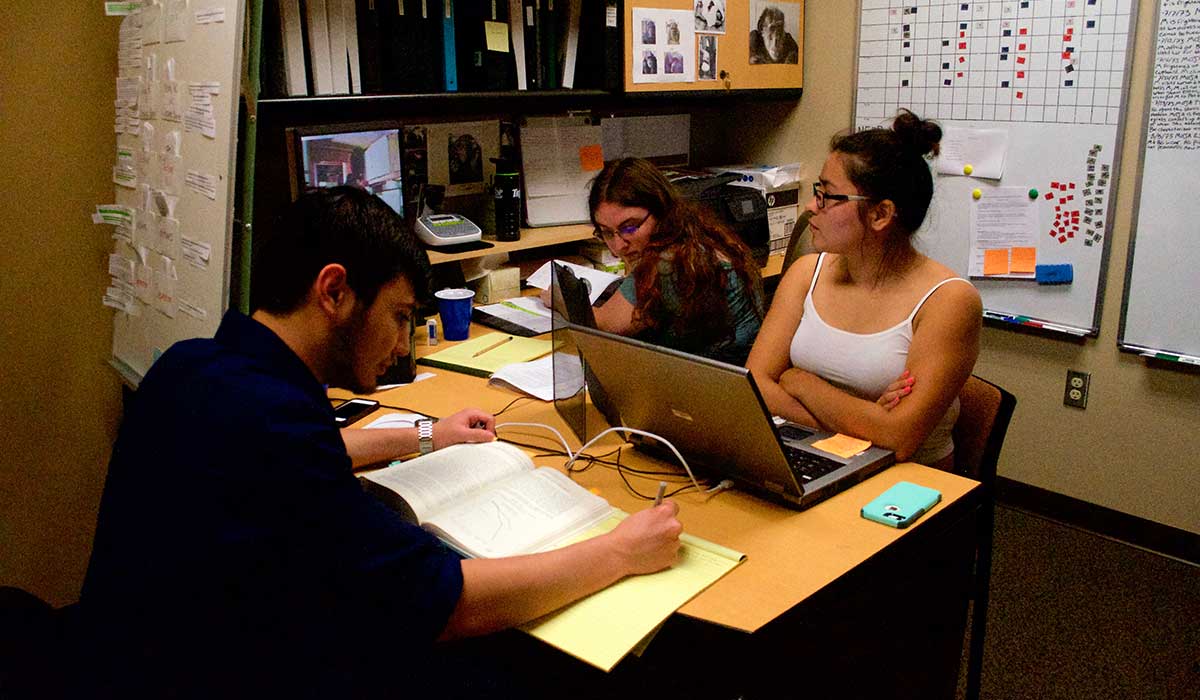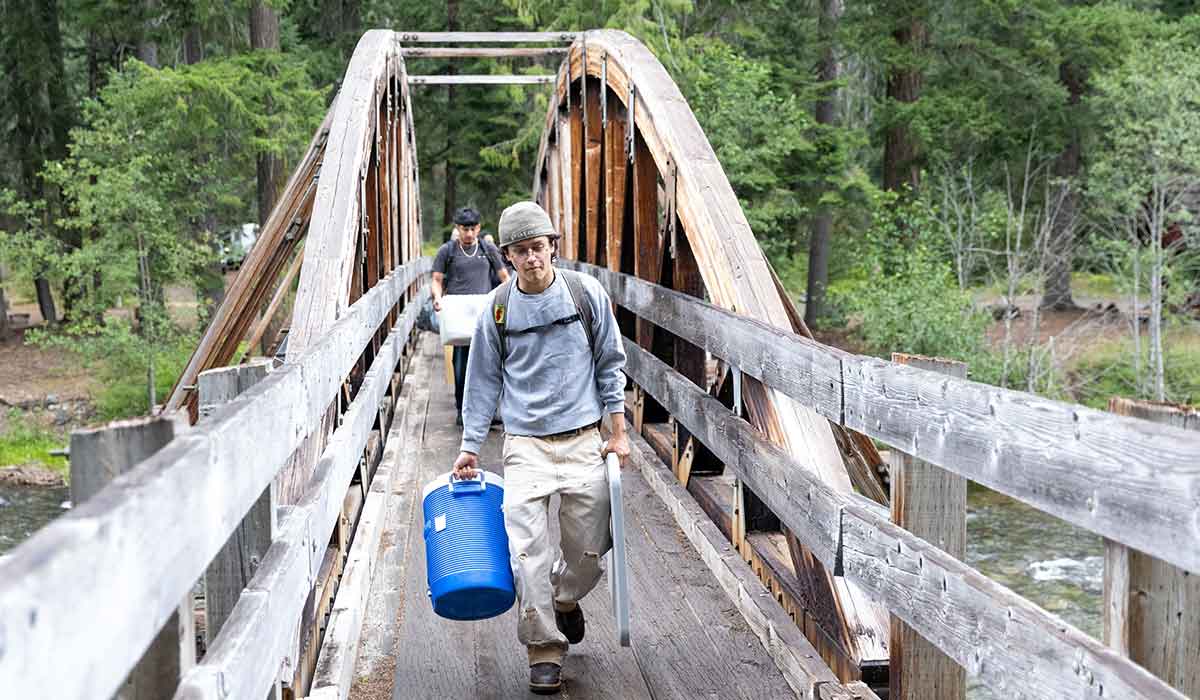From labs to the field, Yakima Valley College students are exploring real-world problems through their undergraduate research projects.
The projects provide students the opportunity to work with a variety of community partners and gain hands-on research experience, something that isn’t always an option at the community college level. More than 300 YVC students have participated in undergraduate research since the program began in 2012.
"At YVC, we're committed to empowering our students to become active participants in scientific discovery,” said Cristy Rasmussen, STEM director. “Our undergraduate research program offers them a unique opportunity to collaborate with experts, explore their passions and make a tangible difference.”
Shaw works with chimps

ABOVE: From left, students Jadrien Gonzalez, Katherine "Katie" Bueschelman, Merivet Lombera work on undergraduate
research in Heidi Shaw's office in Glenn Anthon Hall in 2017. TOP: Vanessa Canales
talks with vendors at the Downtown Yakima Farmers Market in July 2024.
Psychology Instructor Heidi Shaw has been doing research and learning about human and animal behavior since taking a bus west from Massachusetts in 1983 to attend Central Washington University (CWU) and work with chimpanzees that use sign language.
Shaw started working at the Friends of Washoe chimpanzee lab (later Chimpanzee and Human Communication Institute) at CWU as a freshman, and worked there until December 2000 in various capacities, from volunteer to supervisor and research technician.
During this time she also began studying and working with mentors Allen and Beatrix Gardner who are best known for their ground-breaking cross-fostering project with the chimpanzee Washoe, the first non-human to learn American Sign Language.
“The research contributes to society's understanding of how humans fit into the broader animal kingdom,” said Shaw. “Findings from this research were used to justify the use of sign language with groups other than deaf and hard of hearing [individuals], like infants born with Down syndrome and others. In addition, groups concerned with the welfare of other species have used findings from this research to modify federal legislation about how other species must be housed and be treated in captivity.”
In 1995 she joined the faculty at YVC and almost immediately began involving the college’s students in her research.
“Undergraduate research projects are a testament to the incredible potential of community college students." — Cristy Rasmussen, STEM Director
With a bachelor’s degree in interdisciplinary studies, which combined psychology, anthropology and biology, and master’s and doctoral degrees in experimental psychology, Shaw has been studying behavior and communication for over three decades. “This is different than other STEM projects on campus,” said Shaw. “This project began with Washoe in 1966 and is ongoing. Students come in and contribute to whatever the project is doing at the moment.”
When the Gardner’s first began their research, Shaw said, the common belief was that other species couldn’t use human language. Because of this, the cross-fostered chimpanzees were held to stricter guidelines than their human counterparts with regard to learning sign language.
When Allen Gardner gave Shaw a full set of research records, she saw it as a way that YVC students could assist with the project more effectively. Currently, Shaw’s research with YVC students focuses on digitizing research records and comparing the chimpanzees’ vocabulary sizes when different criteria are used.
“Through this process YVC students have learned more about the tedious side of the scientific process and the value of precision, defining variables and learning from mistakes,” said Shaw.
Shaw has worked with more than 100 YVC students on various research projects.
“Many of my research students were parents and could relate what they read about in the research records to what their own children were doing at home,” as they built their vocabularies said Shaw. “In doing so, they were able to relate the research questions to their own lives.”
Summer projects make an impact
 Students working with mentor Suki Smaglik carry supplies to carbonated springs in
the foothills of Mt. Rainier.
Students working with mentor Suki Smaglik carry supplies to carbonated springs in
the foothills of Mt. Rainier.
Vanessa Canales was one of 20 STEM students who engaged in community-based research projects this past summer. The projects helped students develop hands-on, practical skills while also studying issues of interest to local communities and industries.
For her project, Canales worked with Nutrition Instructor Sarah Panarello, to examine the nutrient composition of foods available at the Downtown Yakima Farmers Market and their relationship to health and disease. She also explored the broader implications of her findings for people in the Yakima area.
“It was a great learning experience for me,” said Canales. “There was a lot of communication between students and mentors, which made the whole process really easy and straightforward.”
The project focused primarily on foods available through supplemental food programs such as WIC, senior meals, EBT and SNAP which are heavily used by YVC students and other families in the Yakima Valley.
Engaging in the projects provided Canales and her fellow students with valuable experience in both lab and field settings, along with the opportunity to work with a variety of community partners.
“I think our project had not only impact with our campus but with the larger community as well,” said Canales. “There are a lot of resources out there for the community, but the issue is spreading the information to the right people. I wanted this project to help bridge that gap.”
In addition to presenting their research findings at YVC’s annual summer research symposium and having their research posters displayed in Glenn Anthon Hall, Canales’ group created pamphlets that are available in the YVC Food Pantry with information about community resources and information learned through their research. Canales was also able to share this material with other colleges in our state.

Students working at the U.S. Department of Agriculture molecular genetics lab in Wapato
in July 2024.
Other projects that students worked on this year included:
- Students in one research group collected edible morels and several varieties of poisonous false morels, which contain the toxin gyromitrin. True morels reportedly contain trace amounts of gyromitrin, and students quantified the toxin content of both true and false morels, determining whether cooking to remove toxins is necessary and explored the possible ecological purpose of the toxin by addressing whether it had antibacterial or insecticidal properties. A second student group measured the concentration levels of gyromitrin in the morels.
- Students worked at the U.S. Department of Agriculture molecular genetics lab in Wapato,
exploring how Colladonus genus leafhoppers transmit a plant pathogen (phytoplasma
bacteria) that is devastating the cherry industry in Washington. Using RNA and DNA
technologies, students looked for genes that are expressed in phytoplasma-infected
versus uninfected leafhoppers.
- Students and mentor Suki Smaglik analyzed the chemistry and environmental DNA in naturally
carbonated springs in the foothills of Mt. Rainier. Students set up and worked in
field laboratories to analyze the water chemistry at multiple sites in real time and
collected samples for DNA sequencing.
- Students used molecular techniques, such as DNA sequencing and chemical analysis, to examine samples from soil and waterways in the Yakima Valley that are critical to supporting our ecosystem.
Learn more about YVC’s STEM pathway and programs of study.
Story by Stefanie Menard, AA-DTA ’05, communications consultant. Photos by Menard, Dustin Wunderlich, director of community relations, Matt Barton, graphic designer/multimedia content producer, and courtesy of Heidi Shaw.
